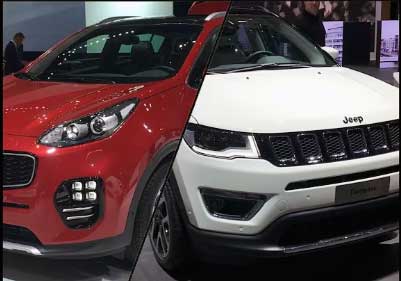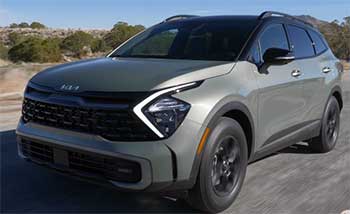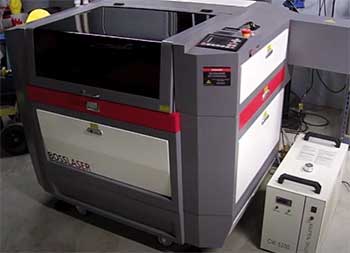I’ve been on the hunt for a compact SUV that balances style, practicality, and adventure-ready grit, and you’re probably in the same boat. The Jeep Compass and Kia Sportage are two heavyweights in this crowded segment, each vying for your attention with distinct strengths.
In this article, I’ll walk you through my experience comparing these vehicles, weighing their pros and cons from a real driver’s perspective. Whether you’re navigating city streets or craving off-road thrills, I’ll help you decide which SUV fits your life best.

Comparison Table: Jeep Compass vs. Kia Sportage (2025 Models)
| Feature | Jeep Compass (2025) | Kia Sportage (2025) |
| Starting MSRP | $28,895 | $28,785 |
| Powertrain | 2.0L Turbo I4, 200 hp, 221 lb-ft torque | 2.5L I4, 187 hp, 178 lb-ft torque |
| Fuel Economy (City/Highway/Combined) | 22/30/25 MPG | 25/32/28 MPG |
| Cargo Space (Behind Rear Seats/Max) | 27.2/59.8 cu ft | 39.6/74.1 cu ft |
| Ground Clearance | 8.1 in (9.1 in Trailhawk) | 8.3 in (X-Pro) |
| Drive Type | Standard AWD | FWD standard, AWD available |
| Infotainment | 10.1-in touchscreen, Uconnect 5, wireless Apple CarPlay/Android Auto | 8-in touchscreen (12.3-in available), wired Apple CarPlay/Android Auto |
| Warranty | 3 yr/60,000 km comprehensive, 5 yr/100,000 km powertrain | 5 yr/100,000 km comprehensive, 5 yr/100,000 km powertrain |
| Safety Rating | NHTSA 4-star, IIHS Top Safety Pick (specific trims) | NHTSA 4-star, IIHS Top Safety Pick (specific trims) |
| Key Off-Road Trim | Trailhawk | X-Pro |
My Journey with the Jeep Compass and Kia Sportage
As someone who loves the open road but also needs a practical daily driver, I took both the 2025 Jeep Compass and Kia Sportage for a spin to see how they stack up. I drove through city traffic, tackled some light off-road trails, and even packed them with gear for a weekend getaway. My goal was to understand what makes each SUV tick and whether they live up to their promises.
Here’s what I found, broken down into key areas that matter most to you and me.
Design and Style: Making a Statement
Jeep Compass
The Jeep Compass has that unmistakable Jeep DNA. Its boxy silhouette, seven-slot grille, and rugged stance scream adventure. I’ll admit, when I first saw the Compass Trailhawk parked outside my local dealership, it looked ready to conquer a mountain.
The 2022 refresh gave it a sharper, more modern edge with sleek LED headlights and a body-colored bumper that adds a touch of polish.
Inside, the cabin feels upscale, especially in higher trims like the High Altitude. The soft-touch materials and redesigned dashboard gave me a premium vibe, though I noticed some hard plastics in lower trims that felt a bit cheap.
Pros:
- Iconic Jeep styling that turns heads.
- Trailhawk trim adds aggressive off-road aesthetics.
- Premium interior in higher trims with luxury-grade leather options.
Cons:
- Lower trims have some low-rent materials.
- Exterior design might feel too traditional for some.
Kia Sportage
The Kia Sportage, on the other hand, is a bold departure from the ordinary. Its “Opposite United” design philosophy gives it a futuristic, angular look with boomerang-shaped LED headlights and a “Tiger Nose” grille. When I pulled up to a coffee shop in the Sportage X-Pro, people couldn’t stop staring.
The cabin is equally striking, with a sleek 12.3-inch touchscreen in higher trims and a modern layout. However, the base LX model’s cloth seats and 8-inch screen felt a bit basic compared to the Compass’s standard 10.1-inch display.
Pros:
- Eye-catching, modern exterior design.
- Spacious and tech-forward interior in higher trims.
- Contrasting roof and sharp LED lights add flair.
Cons:
- Base model interior feels less premium.
- Some blank panels on the console in mid-tier trims.
Performance: Power and Handling
Jeep Compass

Under the hood, the Compass packs a 2.0-liter turbocharged inline-four engine, churning out 200 horsepower and 221 pound-feet of torque.1 It’s paired with an 8-speed automatic and standard all-wheel drive (AWD).2
On my test drive, the Compass felt peppy enough for city merging and highway cruising, but it’s not exactly a speed demon.
The Trailhawk trim’s off-road prowess shone through when I tackled a muddy trail—its 9.1 inches of ground clearance, skid plates, and Selec-Terrain system with Rock mode made light work of rough terrain.
However, the engine can feel strained under heavy acceleration, and the ride on paved roads isn’t as smooth as I’d hoped.
Pros:
- Strong torque for confident acceleration.
- Standard AWD across all trims.
- Trailhawk’s off-road capabilities are unmatched in the segment.
Cons:
- Engine feels underpowered at higher speeds.
- Ride quality can be stiff on rough roads.
Kia Sportage

The Sportage’s base 2.5-liter inline-four delivers 187 horsepower and 178 pound-feet of torque, paired with a 6-speed automatic.3 Front-wheel drive (FWD) is standard, with AWD available.
I found the Sportage’s power delivery smooth and adequate for daily driving, though it lacks the Compass’s low-end grunt.
The X-Pro trim, with 8.3 inches of ground clearance and all-terrain tires, handled a gravel path with ease, but it’s not as trail-ready as the Compass Trailhawk. The Sportage’s ride is notably smoother on pavement, making it a comfier choice for long drives.
Pros:
- Smooth and refined ride quality.
- Optional hybrid and plug-in hybrid powertrains for better efficiency.
- Responsive handling in urban settings.
Cons:
- Less torque than the Compass.
- AWD not standard, which might disappoint off-road enthusiasts.
Interior Space and Comfort
Jeep Compass
The Compass is marketed as a compact SUV, but its interior feels a bit snug. Front-row legroom is generous at 41.8 inches, but the second row’s 38.3 inches of legroom felt cramped when I had taller friends in the back. Cargo space is another pain point—27.2 cubic feet behind the rear seats is decent but lags behind competitors.
Folding the seats gives you 59.8 cubic feet, which was enough for my camping gear but not much else. The seats themselves are comfortable, especially in the High Altitude with its heated and ventilated options, but I wished for more rear-seat headroom.
Pros:
- Comfortable front seats with premium options.
- Quiet cabin with added sound deadening in higher trims.
- Functional layout for daily use.
Cons:
- Tight second-row legroom and headroom.
- Limited cargo space compared to rivals.
To Further Protect Your Interior: Yitamotor Floor Mats vs. WeatherTech
Kia Sportage
The Sportage is a game-changer for space. With 41.4 inches of front legroom and a generous 41.3 inches in the rear, I could stretch out comfortably in both rows. At 189 cm tall, I appreciated the headroom, though my kid complained about the high window sill limiting his view.
The cargo area is a standout—39.6 cubic feet behind the rear seats and 74.1 cubic feet with them folded. I easily fit a stroller, groceries, and a cooler for a family picnic. The interior feels airy, but the base model’s cloth seats didn’t impress me as much as the Compass’s leather options.
Pros:
- Spacious second row for adults and kids.
- Massive cargo capacity for gear-heavy trips.
- Modern, open cabin design.
Cons:
- Base model seats feel less luxurious.
- Rear window sill might obstruct kids’ views.
Technology and Infotainment
Jeep Compass
The Compass’s Uconnect 5 system is a highlight. Its standard 10.1-inch touchscreen is crisp, responsive, and supports wireless Apple CarPlay and Android Auto. I paired my phone in seconds, and the interface was intuitive for navigation and music.
Higher trims offer a 9-speaker Alpine audio system and a wireless charging pad, which I found super convenient. However, the voice recognition occasionally misunderstood my commands, and the base model lacks some of the fancier tech found in pricier trims.
Pros:
- Large, user-friendly touchscreen standard.
- Wireless smartphone integration is seamless.
- Premium audio options elevate the experience.
Cons:
- Voice recognition can be hit-or-miss.
- Some tech features locked to higher trims.
Kia Sportage
The Sportage’s tech is solid but varies by trim. The base 8-inch touchscreen feels small compared to the Compass, but the available 12.3-inch display is stunning. Wired Apple CarPlay and Android Auto are standard, which meant I had to keep a cable handy.
The interface is clean, and Kia’s UVO Link services add connectivity, but I missed the wireless convenience of the Compass. The standard safety suite, including blind-spot monitoring and lane-keeping assist, worked flawlessly during my drives.
Pros:
- Large, vibrant touchscreen in higher trims.
- Comprehensive standard safety tech.
- Intuitive interface with UVO Link services.
Cons:
- Base 8-inch screen feels dated.
- Wired smartphone integration is less convenient.
Safety and Reliability
Jeep Compass
Safety is a strong suit for the Compass, with a 4-star NHTSA rating and an IIHS Top Safety Pick for specific trims. Standard features like forward-collision warning, automatic emergency braking, and blind-spot monitoring gave me peace of mind in traffic.
The Trailhawk’s off-road safety features, like skid plates, are a bonus for adventurous drivers. Reliability, however, is a mixed bag. J.D. Power gave the Compass an 82/100 for driving experience, but user reviews on forums like Reddit highlight concerns about long-term dependability, especially with older models.
Pros:
- Robust standard safety features.
- IIHS Top Safety Pick for certain trims.
- Off-road safety enhancements in Trailhawk.
Cons:
- Reliability concerns based on user feedback.
- Some systems, like lane-keep assist, can be overly sensitive.
Kia Sportage
The Sportage matches the Compass with a 4-star NHTSA rating and IIHS Top Safety Pick status for specific trims. Its standard safety suite is comprehensive, with pedestrian detection and a driver-monitoring system that kept me alert during long drives. J.D. Power rated the Sportage’s driving experience at 78/100, but its reliability shines brighter.
Kia’s reputation for dependability, backed by a class-leading 5-year/100,000 km warranty, gave me confidence that it’ll last longer without major issues.
Pros:
- Excellent standard safety features.
- Strong reliability reputation.
- Industry-leading warranty.
Cons:
- Slightly lower J.D. Power driving score.
- Some safety systems require higher trims for full functionality.
Fuel Economy and Efficiency
Jeep Compass
The Compass’s fuel economy is decent but not class-leading. With 22 MPG city, 30 MPG highway, and 25 MPG combined, it’s thirstier than the Sportage. During my week-long test, I averaged about 24 MPG in mixed driving, which meant more frequent stops at the gas station.
The lack of hybrid options is a drawback, especially as competitors like the Sportage offer electrified powertrains for better efficiency.
Pros:
- Respectable highway fuel economy.
- Consistent performance across driving conditions.
Cons:
- No hybrid or plug-in hybrid options.
- Below-average city fuel economy.
Kia Sportage
The Sportage edges out the Compass with 25 MPG city, 32 MPG highway, and 28 MPG combined. I hit around 27 MPG in real-world driving, which felt easier on my wallet.
The availability of hybrid and plug-in hybrid models is a game-changer—Kia claims up to 43 MPG combined for the hybrid, which I didn’t test but sounds appealing for eco-conscious buyers. The X-Pro’s all-terrain tires slightly dent efficiency, but not enough to be a dealbreaker.
Pros:
- Better fuel economy than the Compass.
- Hybrid and plug-in hybrid options for efficiency.
- Competitive real-world MPG.
Cons:
- AWD models are less efficient.
- Base engine isn’t as thrifty as hybrids.
Pricing and Value
Jeep Compass
The Compass starts at $28,895, slightly higher than the Sportage. The range-topping Trailhawk can push past $40,000, which feels steep for a compact SUV. In Canada, pricing ranges from $33,700 to $50,600, per Driving.ca.
The standard AWD and larger touchscreen add value, but I felt the higher trims were overpriced compared to the Sportage’s loaded models. Still, if off-roading is your thing, the Trailhawk’s capabilities justify the cost.
Pros:
- Standard AWD adds value.
- Competitive base price for features.
- Trailhawk offers unique off-road appeal.
Cons:
- Higher trims feel overpriced.
- Fewer powertrain options limit value.
Kia Sportage
The Sportage starts at $28,785, just under the Compass, and tops out at $50,595 in Canada. Its base model feels like a better deal with more standard safety features, and the hybrid options add long-term savings. I was impressed by the EX trim’s balance of tech and comfort for the price. The 5-year warranty seals the deal for value-conscious buyers like me.
Pros:
- Slightly lower starting price.
- More powertrain options for flexibility.
- Outstanding warranty enhances value.
Cons:
- AWD costs extra.
- Base model tech feels underwhelming.
Driving Experience: City vs. Trails
I took both SUVs through a mix of urban streets, highways, and light off-road trails to get a feel for their personalities. The Compass felt at home on a rocky path near my local park, where its AWD and Trailhawk trim’s crawl ratio made short work of uneven terrain. In the city, though, its stiff suspension made potholes jarring.
The Sportage was the opposite—its smooth ride and nimble handling were perfect for commuting, but it felt less confident on rough trails. If you’re mostly a city driver, the Sportage’s comfort wins; for off-road adventures, the Compass is king.
Which One Fits Your Lifestyle?
After spending time with both, I can see why the choice is tough. The Jeep Compass is for you if you crave adventure and want a vehicle that can handle snow, mud, or rocky trails without breaking a sweat. Its standard AWD and Trailhawk trim make it a standout for off-road enthusiasts, but its smaller interior and so-so fuel economy might frustrate daily commuters.
The Kia Sportage, meanwhile, is your pick if you want a spacious, tech-savvy SUV with better fuel efficiency and a stellar warranty. It’s less capable off-road but shines in comfort and value.
Discover More: Rotella T6 vs. Amsoil
Frequently Asked Questions (FAQ)
It depends on your needs. The Compass excels for off-road adventures, while the Sportage is better for daily comfort, space, and efficiency.
Kia has a stronger reliability reputation, backed by its 5-year/100,000 km warranty. Jeep’s reliability is improving but trails Kia based on user feedback.
The Jeep Compass is generally good, especially post-2017 models with improved interiors and tech. It offers solid off-road capability and fuel efficiency but may feel underpowered with the base engine and pricier than competitors.
The Sportage competes with compact SUVs like the Jeep Compass, Toyota RAV4, Honda CR-V, and Hyundai Tucson.
Conclusion
As I’ve explored the Jeep Compass and Patriot, I’ve seen how each offers a unique take on Jeep’s legacy. The Compass brings modern flair and efficiency, perfect for those balancing city life and weekend adventures. The Patriot, with its classic look and budget-friendly price, appeals to purists and bargain hunters.
Your choice depends on what you value—style and tech or affordability and simplicity. Test-drive both to feel their vibe, and let your needs guide you to the Jeep that’ll join you on your next journey. Happy driving!

